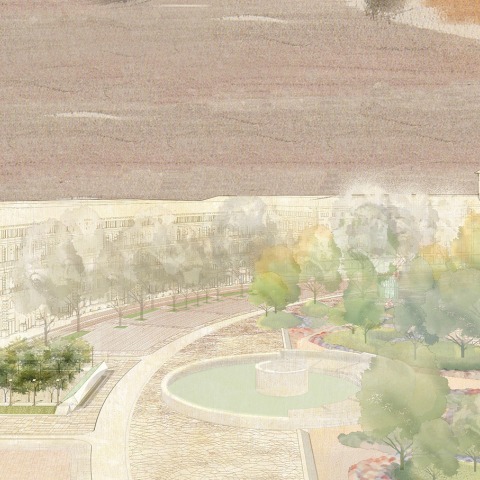Description by Massimo Mazzone
To Spoil a Choice, or the “Not-so-Strange” Case of Piazza Castello’s Competition
More than few people foresee that, following the United Kingdom discharge from the UE, Milan will substitute London by assuming the latter’s identity as “City of Europe”. In this sense, since January 2017, the big financial consortiums and the Italian Government are setting the conditions finalized to tune the necessary laws to secure this internationally prestigious position.
It is undisputable that Milan represents the economic capital of Italy. Its modernity is expressed by a true civility of dwelling. However, starting from the dawn of the new millennium, the city has been shored up by colossal cathedrals of glass and steel, true temples of the economic power, erected by this or that multinational, banking or insurance group.
Thus, the image through which the monetary capital has peremptorily chosen to express its status is gradually overlapping the shape of the whole city, modifying it in a compulsory way and with no chance of remedy.
The alarming fact is that these impositions are not only welcomed with widespread indifference as current practice, rather that, in most cases, they are lauded as progress’ bearer: true vessels, charged with the task of ferrying the dull present toward a brighter future. Many, among Milan’s citizens and the goers, seem unaware of the character loss the city is living, and to the provincialism expressed by the conformation to the globalized world’s dominant images. Hence, they mistake as clever innovation the arrival of a futuristic computer store or of a pretentious coffee shop’s franchising, bringing a huge crystal cube in the center of Piazzetta Liberty or a palm grove in Piazza del Duomo.
The paradox is that, instead, whether is up to the Public Administrations – direct representation of the citizens of Milan – to decide of the city’s future image, they answer with a hypocrite “sense of measure”, which translates into the ostracism of architecture as carrier of meaning.
The last – but most likely not final – proof of this “not-so-strange” case is the International Design Competition Piazza Castello – Foro Buonaparte’s outcome, published last February the 4th.
In fact, the jury decided to award with the first prize a design which, through few cosmetic operations, “embellish” the square and gives up from the start to the chance of giving an interpretation to space, which is architecture’s authentic task.
Hence the forms, drained from any kind of content and value, have the strange power to not convey any point of view, cunningly avoiding the danger of exposing themselves to the public opinion’s guillotine and the subsequent risk of consent (thus votes) loss.
In short, by clumsily evoking the image of Paris’ esplanades, the winning design proposes to cover the whole Piazza Castello’s area with white stabilized gravel, and provide the space with a certain number of graceful kiosks which seem directly extrapolated from some painting of Pissarro.
We find ourselves, at this point, to face another paradox. In fact, by trying not to expose itself from a political and economic point of view, the Public Administration selected a design which is totally foreign to the character of Milan, ultimately choosing an alien.
It is striking, for instance, the material’s choice: in fact, from one side, Milan is a city which always preferred to pave the spaces in front of monuments and institutional buildings with stone, from the other, the white stabilized gravel is a very delicate material, which easily deteriorates and needs a continuous maintenance, which gets dirty during winter and blinds in summertime.
It is left to wonder how the design, which evidently is the best of the selected ten, has been placed only at the third place(Torricelli). It is, indeed, a project which is capable of enacting the relation between tradition and innovation with a remarkable interpretative capacity and with forms that are appropriate to one of the most eminent places of the city.




























